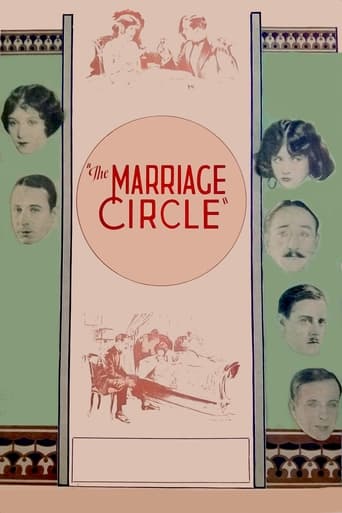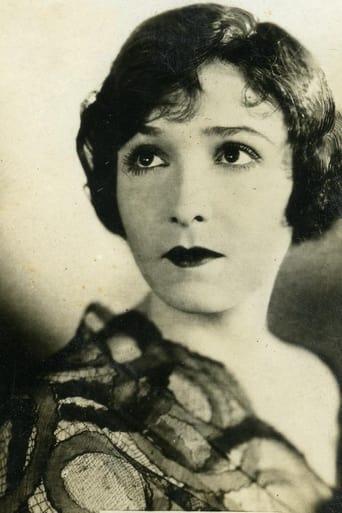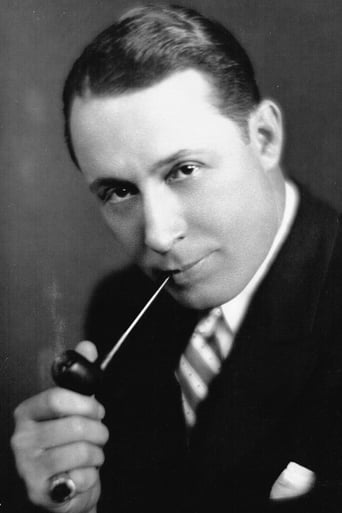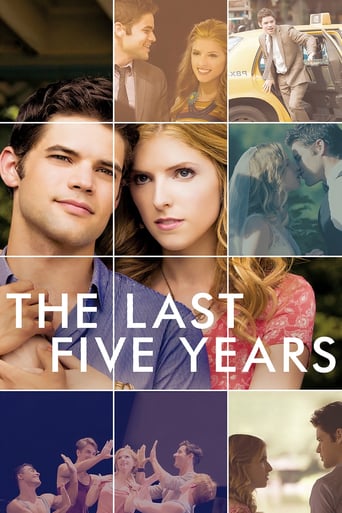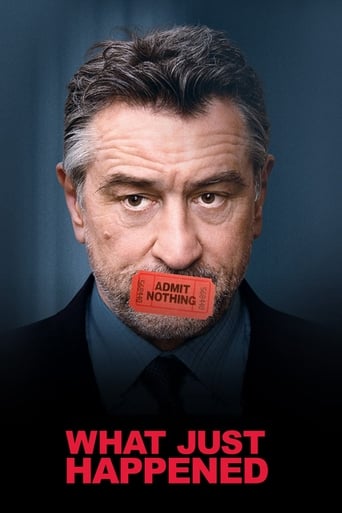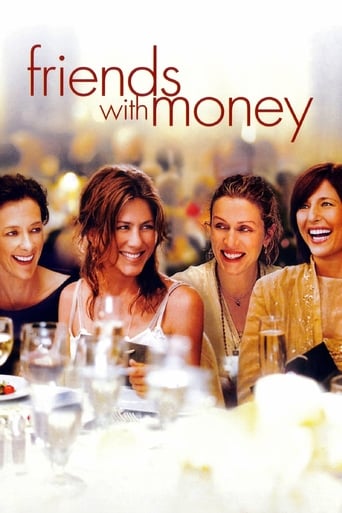The Marriage Circle (1924)
Professor Stock and his wife Mizzi are unhappily married. The professor, suspicious of his wife, hires a detective to spy on her in hopes of obtaining a divorce. Mizzi sets her sights on seducing Dr. Franz Braun, the new husband of her good friend Charlotte. Dr. Braun's colleague, Dr. Mueller, who has his eye on Charlotte, sees this as his opportunity. Through a misunderstanding, Charlotte thinks that her husband is interested in Miss Hofer, and asks Mizzi to keep him occupied... around and around the circle goes in Lubitsch's refined comedy of mistaken infidelity.
Watch Trailer
Cast
Similar titles

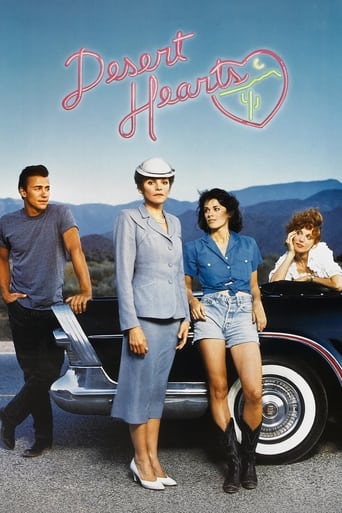
Reviews
I love this movie so much
Pretty good movie overall. First half was nothing special but it got better as it went along.
It is neither dumb nor smart enough to be fun, and spends way too much time with its boring human characters.
There are moments in this movie where the great movie it could've been peek out... They're fleeting, here, but they're worth savoring, and they happen often enough to make it worth your while.
Professor Stock (Adolph Menjou) and wife Mizzi (Marie Provost) have reached an impasse in their marriage and he wants out. Mizzi's best friend Charlotte ( Florence Vidor ) is blissfully married to Dr. Charles Braun (Monte Blue). His partner Dr. Mueller (Creighton Hale) has designs on Charlotte who has no interest. When Mizzi sets her sights on Dr. Braun suspicions, stoked by misinterpretation and the diabolical Mizzi arise and accusations fly.The Marriage Circle is an excellent comedy of errors from the Silent Era featuring the wit and sophistication of Ernst Lubitsch that would go on to brilliantly inform some of the finest adult comedies before and after sound and code enforcement. Here he breezily unfolds his story with a benign amorality and suspense as his quintet of characters all share a little guilt and selfishness. Vidor is a beauty and paragon of virtue to behold but capable of being petty. Blue and Hale comically pine and mope while Menjou is pure dinner at eight collected. Acting honors however belong to Provost's Mizzi whose side glances and brashness haul the rest of the characters into the circle. The Marriage Circle is an outstanding example of silent film comedy and in large contrast to the slapstick that still dominated. Doors are closed, not slammed or run through, the humor is sly not pie in the face. Lubitsch conveys it beautifully here as he would into sound as well as influence a generation of filmmakers.
Silent cinema is not inherently inferior to the sound cinema, but many silent pictures, especially those from the early-to-mid 1920s, seem stilted in comparison to their talkie counterparts due to an over-reliance on title cards, and a lack of faith in the audience's ability to "read" images. Fortunately, they aren't all like this, thanks to the inventive boldness of the era's greatest filmmakers.To start at the very beginning (a very good place to start), The Marriage Circle is the first comedy Ernst Lubitsch made in Hollywood. It's been pointed out that there was an abrupt change in pace compared to his earlier Berlin comedies, which were non-stop riotous farces. This is true, but The Marriage Circle also sees an enormous shift in tone. Lubitsch's pictures in his home country were absurd to the point of being surreal, staged with an emphasis on exaggeration and peopled with theatrical caricatures. The Marriage Circle however depicts a reasonably realistic situation, albeit a comically improbable one. There is no slapstick here, but neither is it a witty verbal comedy. Instead the humour derives from numerous misunderstandings as five characters become innocently entangled a complex love pentagon. In this, the audience is omniscient – we know everything that is going on – whereas each character knows only enough to make them misconstrue. Lubitsch's problem then, was how to convey this to the audience without spoon-feeding them every detail, and above all keep it funny.He does it, not just by showing us everything, but by showing us how things are seen by everyone. The camera is never merely presentational; it is always within the action. In virtually every shot, we are either seeing things from a character's point of view or we are focusing on a character's reaction. The angles are never external, watching the players interact with one another; they are always down the line, putting us inside the interaction. And Lubitsch is brave enough – and knows we are intelligent enough – to switch quickly from one perspective to another. For example, in the scene where Mizzi (thinking she is onto something) embraces Dr Braun, we go from Muller seeing them from behind and assuming Mizzi is Charlotte, to his seeing Charlotte in the waiting room (and thus realising the woman in the embrace can't have been Charlotte), to Braun realising Charlotte is watching, to Charlotte realising Braun has been dallying with a female patient whom she doesn't realise is Mizzi! As you can see, it all sound rather confusing when put it into words, but on screen it's a cinch to follow.But that's not all that's going on here. As well as getting the right angles on the action, Lubitsch throws in some subtle tricks to imply rather than state the way things are. In the opening scene, it is clearly established that the Stocks's marriage is not the most harmonious, but it is one simple moment that reveals the true extent of the breakdown. Adolphe Menjou sees his wife get into a cab with another man, assuming (wrongly of course!) she may be having an affair. He turns to the camera, his expression unreadable. And then, slowly, a smile spreads over his face.And this leads me neatly onto the next point, that it is as much the skills of the actors that make this wordless fiasco workable. The two lead men, Adolphe Menjou and Monte Blue, are not comedy actors in the normal sense, but they exhibit great comic timing and control. Just as the story is believable but unlikely, their performances are naturalistic but extreme. Menjou is the master of the withering glance and the long-suffering sulk. You get the impression, just by looking at his face, that here is a man who was not cut out for marriage. Blue, on the other hand, expertly portrays the complete opposite, a modest and honest man who seems unaware of his own attractiveness. You pick up his character from some neat little gestures; such as him nervously pulling at his collar to cool off – something you normally only see cartoon characters doing. Florence Vidor has the restrained demeanour of the only entirely normal person caught up in this situation, and gives a wonderful straight performance that counterpoints all the others. Creighton Hale is the only one of the players who is somewhat hammy and unrealistic, but as a more marginal and somewhat ridiculous character, he is allowed, and even helps give the picture its slightly silly edge. Marie Prevost is the only one of the five who is not exceptional, but she is by no means bad, and at least fits the part.Lubitsch himself claimed this was his favourite of all his own pictures, and the only one which if he had to do again he would change nothing. It was well liked by his contemporaries too, and in the dying days of the silent picture you can see a significant move towards more sedate and subtle silent comedies, especially in the work of directors like Rene Clair and Leo McCarey. And after that of course, the talkies would come along, and it would all change again.
007: Marriage Circle (1924) - released 2/10/1924, viewed 7/27/05.Vladimir Lenin dies and Joseph Stalin begins his bid for leadership of Soviet Russia. The 1924 Winter Olympics commence in Chamonix, France. Petrograd is renamed Leningrad. The U.N. recognizes the Soviet Union. Mohandes Gandhi is released from prison on medical grounds. The gas chamber used for the first time in an execution in Nevada.BIRTHS: Sabu Dastagir. DEATHS: Vladimir Lenin, Woodrow Wilson.KEVIN: We now come to a more unusual entry, a silent sex comedy from a soon-to-be-renowned German filmmaker. I didn't know what to expect from Ernst Lubitsch's Marriage Circle. As it turned out, I enjoyed it very much. Each scene seemed funnier and more engaging than the last. I loved the characters, and I was intrigued by the way the film was performed. Although it was probably done often, it seems like it'd be difficult to adapt a stage play, full of spoken dialogue, to the silent screen. But this one does it wonderfully. The actors all do an excellent job of expressing every emotion and nearly every word without us being able to hear them at all, and with very few title cards necessary. We've got plenty more Lubitsch films further along in the sound era, and I'm looking forward to watching them all.DOUG: I must be honest, I didn't think a comedy like this could possibly work as a silent film. There's not a lot of action happening like with Keaton or Chaplin. There are plenty of characters interacting and bickering. I had suspected that this started out as a play before making the leap to film, and this at a time when film and stage were even more different than they are now. With the dialogue cards only revealing the most essential lines, the actors have to absolutely sell it. And they do. It took me a little while to figure out exactly who was who and what everyone was doing, but once I got it, the movie was a lot of fun. There are a lot of good twists and turns that manage to work despite the lack of sound; When Charlotte suspects her husband Franz is having an affair, she enlists her best friend Mizzi to watch him at a party, unaware that it is in fact Mizzi that Franz is having the affair with. We had a lot of fun filling in the dialogue ourselves, and it is never hard to understand what the characters are thinking.Last film: Our Hospitality (1923). Next film: The Thief of Bagdhad (1924).The Movie Odyssey is an exhaustive, chronological project where we watch as many milestone films as possible, starting with D.W. Griffith's Intolerance in 1916 and working our way through, year by year, one film at a time. We also write a short review for each and every film. In this project, we hope to gain a deeper understanding of the time period, the films of the era, and each film in context, while at the same time just watching a lot of great movies, most of which we never would have watched otherwise.
Mainly of interest to those looking for Lubitsch touches, of which there are a goodly number. Hollywood has had a difficult time cleaning up European sex comedies for the American market without losing the zip.This picture is an example of this problem. Very good costumes and sets, but the story is not engaging.
